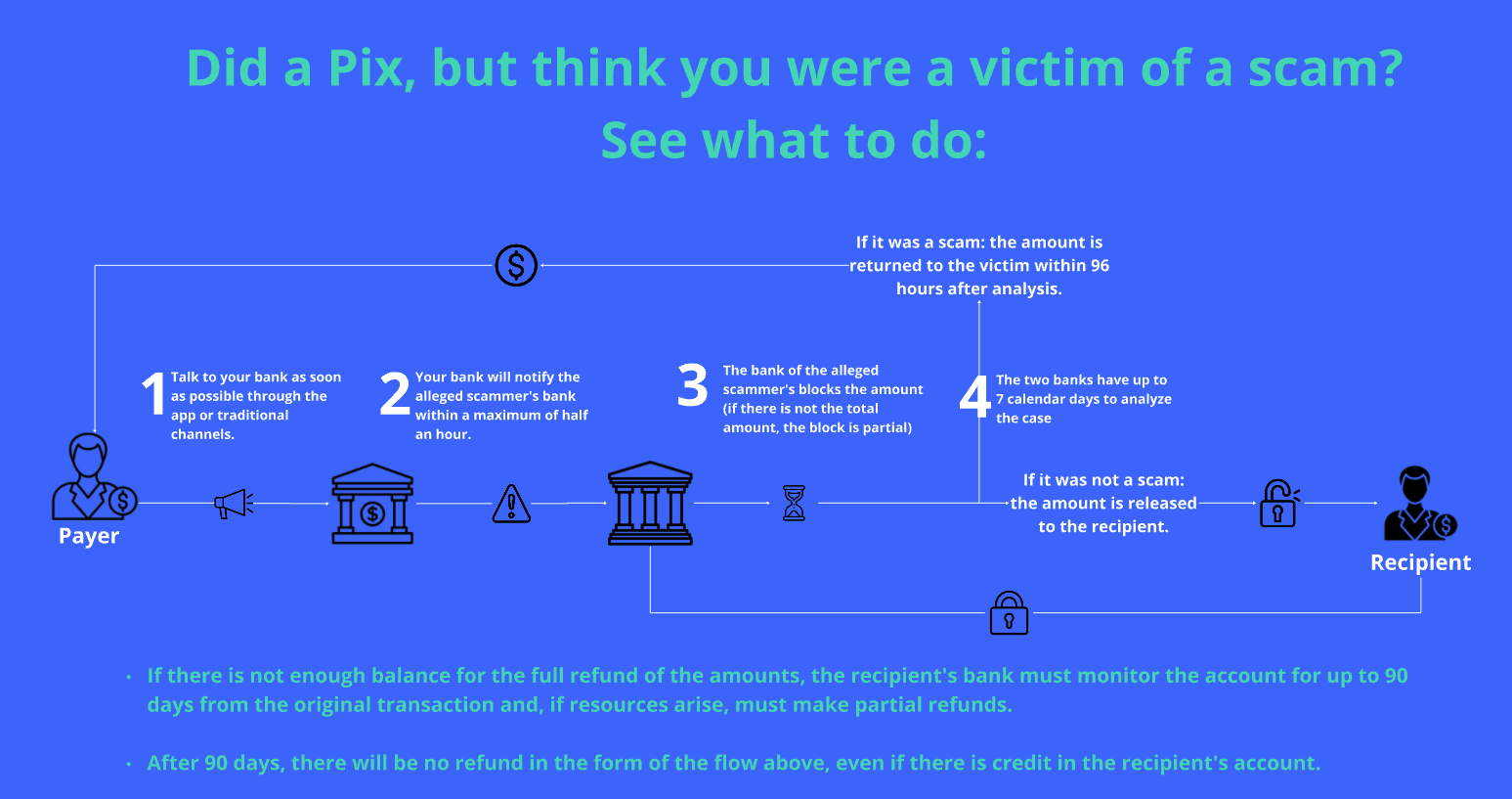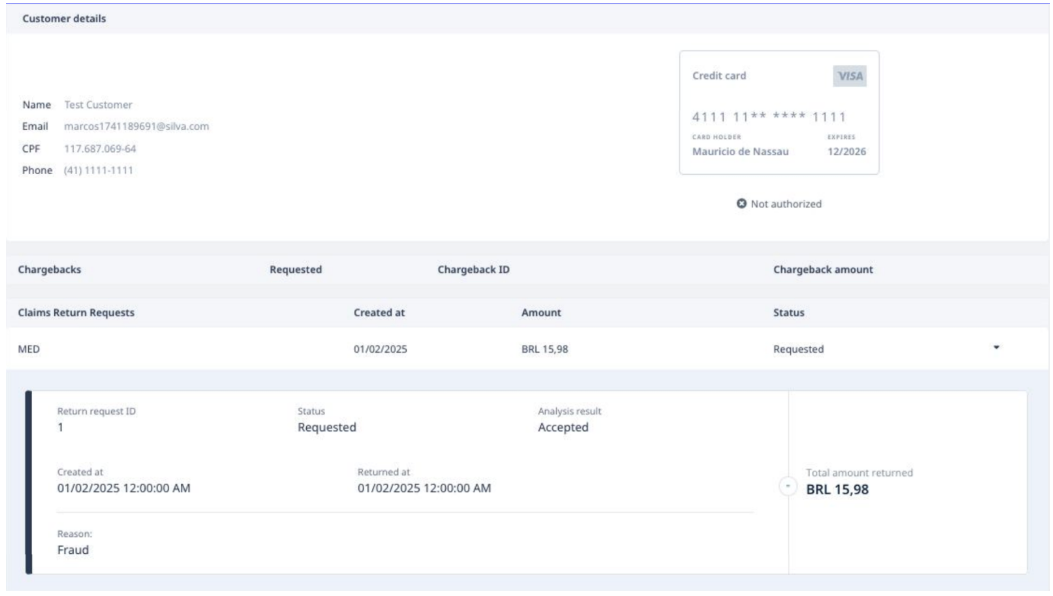MED Pix Overview
The Special Return Mechanism (MED) is a Pix feature established by the Central Bank of Brazil (BACEN) to enable refund requests in cases of fraud or operational failure. All Pix transactions processed by EBANX are regulated by BACEN, and therefore comply with the official Pix arrangement and its fraud-prevention rules. EBANX automates the entire MED process to ensure compliance, security, and transparency for merchants from the first notification to the refund request and settlement update. MED helps protect payers in fraudulent or mistaken transactions, while EBANX ensures merchants are notified transparently and refunds are reflected automatically in settlements.
When a MED Case Occurs?

The MED mechanism is the only one that follows a standardized regulatory flow between financial institutions.
Timelines and Responsibilities
| Step | Responsible Party | Deadline |
|---|---|---|
| Request submission (fraud suspicion) | Payer’s institution. Customer (payer) initiates the refund request with their financial institution | Up to 80 days after the transaction |
| Initial analysis | Receiving institution (EBANX IP) | 7 calendar days |
| Refund execution (after acceptance) | EBANX | Up to 96 hours |
| Merchant response (if requested) | Merchantmay be contacted by EBANX’s Fraud Prevention team to provide additional information within the 7-day analysis period | Up to 3 calendar days, counted within the 7-day window |
- If the fraud claim is accepted, the Pix amount is refunded to the payer, either partially or in full, depending on the available balance in the recipient’s account.
- If the claim is rejected, the case is closed and cannot be reopened.
- Refunds may occur in one or multiple installments, depending on available balance.
- If the recipient’s account is closed, the refund cannot be processed through the MED flow. In these edge cases, the merchant must coordinate directly with the customer to arrange an off-process refund, outside the MED mechanism.
Refund approval does not guarantee fund recovery, as it depends on account availability.
EBANX Operational Flow
The Central Bank of Brazil mandates that all payment institutions enable the MED feature for Pix transactions. EBANX’s infrastructure ensures that merchants experience no manual burden during this process.
How EBANX handles MED
- Full automation of the MED lifecycle - from infraction notification to settlement adjustment.
- No manual dispute managementrequired by merchants.
- Fraud Prevention (FP) team conducts all internal reviews.
- Merchants are contacted only if additional clarification is required.
- Response deadline: 3 days after request from EBANX FP.
- Refunds appear automatically in your settlement statement.
WS/Query notification
Looking always on increase our merchants service level and to fulfill the entire payment flow needs, EBANX has been increasing its tools for claims management, and its current impact for PIX (MED) In that way, informations sent through our API connection was enhanced in a new node inside the current payment API that now have a bigger number of informations that can be used by our merchants to manage its transactions.
Only cases with a final status that result in a debit on the settlement statement will be notified via ws/query. This means you will receive notifications specifically for confirmed fraud cases where the refund is successful and the corresponding amount is discounted from your settlement.
Fields and parameters
| Field name | Field format | Possible values | Description |
|---|---|---|---|
return_request_id | [numeric field] | Claim internal id number; | |
status | [text] | Refunded | Indicates that the MED process has been completed and the refund was successfully executed. This field will always return the value Refunded. |
reason | [text] | FRAUD OPERATION_FLAW REFUND_CANCELLED MONEY_LAUNDERING | Identifies the type of occurrence reported by the financial institution when initiating a MED case. |
rejection_reason | [text] | Free text (e.g., “Insufficient funds”) | When a return request cannot be processed or refunded, this field provides a brief description of the rejection reason. |
claims_type | [text] | MED AML | Identifies the type of claim being processed: med: Standard Pix Special Return Mechanism case. aml: Refund triggered by Anti–Money Laundering protocols. |
date_paid_to_customer | YYYY-MM-DD HH:MM:SS | Date that the claim was returned to the end-user; | |
amount_paid_to_customer | [numeric field] | Total amount returned to the end-user | |
settled_date | YYYY-MM-DD HH:MM:SS | Date where the amount was discounted on your liquidation process; | |
status_settlement | [text] | Settlement status; | |
amount_settled | [numeric field] | Amount of the claim at the time of the liquidation process; |
Example payload
{
"claims": {
"return_request_id": "12",
"status": "Refunded",
"reason": "FRAUD",
"rejection_reason": null,
"claims_type": "MED",
"date_paid_to_customer": "2025-07-01 00:00:00",
"amount_paid_to_customer": "10.0",
"settled_date": "2025-07-01 00:00:00",
"status_settlement": "not_settled",
"amount_settled": null
}
}
Settlement
Refunds related to MED cases are reflected in your settlement as “claim-MED” entries.
- The refunded amount is deducted directly from your next settlement.
- Refunds can be partial or full.
- No additional fees are charged, only the refunded amount is discounted.
- Settlement files and dashboards identify MED transactions for full traceability.
Settlement Report sample
This image shows the Settlement Report, where the value of a MED case is deducted under the field “CLAIMS COST.” The amount appears as a negative adjustment, representing the amount refunded to the payer through the MED flow.

All MED details can be accessed through the “Claims” tab:

In this report view, each line represents a processed MED case. The columns display:
- Request Date: when the notification request was opened;
- Confirm Date: when the refund was confirmed;
- External Reference ID: unique identifiers of the transaction;
- Description: reason for the case.The possible values for MED, are:
- FRAUDULENT_ACCESS
- SCAM
- ACCOUNT_TAKEOVER
- COERCION
- Payment ID: EBANX payment identifier.

- Payment Type (e.g., PIX);
- Claims Type (e.g., MED);
- Local Amount / Amount (USD): original and converted values;
- Customer Document: details of the payer affected.

The report also includes merchant reference fields used for reconciliation and traceability:
- Merchant Payment Code
- Merchant Payment Hash

**Merchant Area info sample **

This screenshot shows how a MED case appears inside the Merchant Area, including:
- Claim return request summary: with key fields such as:
- Claims Type;
- Created at: date when the case was registered;
- Amount: total value of the transaction under analysis;
- Status: current processing stage;
- Reason: cause of the Claim;
- Total amount returned: amount returned to the payer
Frequently asked questions
- What are my Claim costs? There are no additional fees. The only deduction is the refunded amount itself.
- Claim vs. Chargeback What’s the difference between claims and chargebacks? With the goal to centralize other kind of discounts in emerging markets, a claim can be related to regulatory discounts and protection mechanisms a chargeback is related to a consumer protection mechanism only.
- How will I be notified? You will receive an API notification once the MED refund is executed and the corresponding amount is deducted from your settlement — this notification confirms both the refund completion and its financial impact.
Glossary
- Claim - Different from a chargeback, a claim can be a end-user protection mechanism, for specific APM's, or used as a mechanism of banks and acquirers to block transactions to be processed and the funds sent abroad.
- Chargeback - A chargeback is a consumer protection mechanism initiated by a cardholder directly with their issuing bank. This process allows cardholders to reverse a transaction if they believe there's an error or fraud. The issuing bank acts as the intermediary, evaluating the validity of the cardholder's claim.
API Reference
Click here to access detailed API documentation to integrate efficiently.
Mock Customer Data
Click here to view mock customer data for testing and validating user flows.
Error Codes
Click here to review common error codes to troubleshoot and resolve issues quickly.
Still need help?
We hope this article was helpful. If you still have questions, you can explore the following options:
- Merchant support: Contact our support team at sales.engineering@ebanx.com for assistance.
- Not a partner yet? Please complete the Merchant Signup Form, and our commercial team will reach out to you.